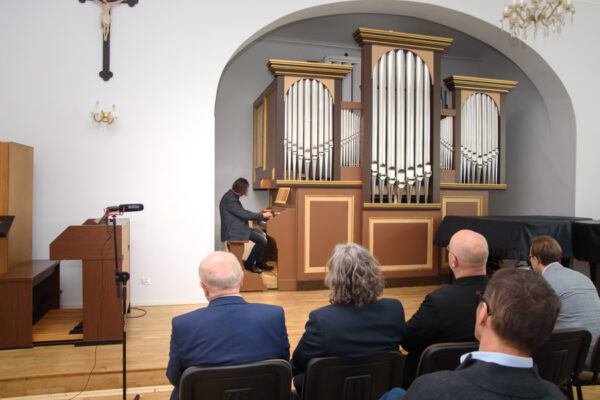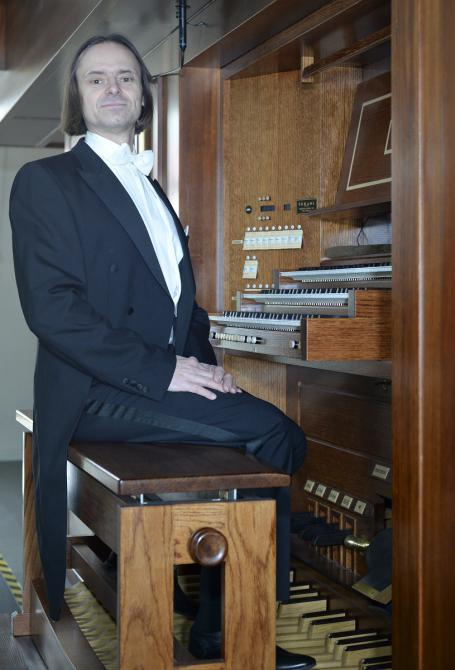| Maria Sztuka |
In June last year, at the Institute of Music of the Faculty of Arts and Educational Science of the University of Silesia in Cieszyn, the pipe organ, which had been silent for many years, sounded again in the chamber hall. The thoroughly reconstructed instrument delighted with its unique timbre, typical of previous centuries, the secret of which lies in the historically preserved sound section and the reconstruction of many organ pipes. The author of the project and the implementer of the revitalisation of the instrument is Tomasz Orlow, PhD, DLitt, Assoc. Prof., organist, improviser, organologist and organ builder.
King of instruments
The phenomenon of the organ fascinated the music masters. The instrument resembles a huge orchestra operated by only one man. Wolfgang A. Mozart gave the organ the name of the king of instruments, from which you can produce an infinitely long sound as long as there is air in the organ. In the past, the windbags were set in motion by organ-blowers, now this function has been taken over by electric drives, so that when a key is pressed, the sound can go on indefinitely.
“No other instrument is able to generate something like this. The dynamics from pianissimo, i.e. the quietest sound that can be produced, to the most powerful fortissimo, is incomparable even with the sound of tutti, i.e. the participation of all performers of a symphony orchestra at the same time. Organs have a much greater power and density of sound”, assures Prof. Tomasz Orlow.
The king of instruments holds no secrets from the Professor. The musician not only conserves and reconstructs historic organs, but also designs and installs them. Above all, however, he is an organist giving concerts in Poland and abroad. Tomasz Orlow graduated with honours from his studies at the Karol Szymanowski Academy of Music in Katowice in the organ class of Prof. Julian Gembalski in 1998. He continued his education in Düsseldorf at the Robert Schumann Hochschule (a scholarship from the Culture Foundation) in the organ improvisation class of Prof. Wolfgang Seifen, the most renowned German improviser. In 2005, he defended his doctoral dissertation (Improvisation as a creative art in the aspect of replica, reconstruction and interpretation of a musical work). The concert, which took place at the Archcathedral of Christ the King in Katowice, was the first entirely improvised organ recital in Poland. T. Orlow devoted his habilitation thesis (2014) to the analysis of organological, conservation and artistic issues related to the reconstruction of the historical pipe organ of the Saint Dorothy Church in Trzcinica and the interpretation of European organ literature of the 16th–18th centuries. Since 2003, the musician has been associated with the University of Silesia in Cieszyn, where he teaches improvisation and interpretation of organ literature. Tomasz Orlow is the winner of the J.P. Sweelinck 3rd International Organ Competition in Gdańsk and a laureate of the 1st International Organ Competition in Warsaw.
Improvisations
The choice of the Katowice Academy was determined by the presence of Prof. Julian Gembalski, who in the 80s was the only improviser in Poland, and his passion infected the students who gave concerts with him.
“After graduation, my interests definitely focused on improvisation. It embodied my passion for playing without notes, composing a piece on the keyboard in front of the audience, a piece that is not and never will be written in notes. It is an ephemeral, one-time and unique art, but the sequence of events that takes place during improvised concerts should lead the listener to believe that this is a piece composed on paper, well thought out, which has a form and is logical. The best compliment to an improviser is when they are asked: Where can I buy this sheet music? Who wrote this piece?”, concludes the organist.
The musician explains the growing interest in improvisation in recent years with the specificity of the present day.
“We live in quite fast times, everything is created hastily, everyone expects an almost instant effect, this momentum is especially preferred by the young generation, which is probably why so many young people are eager to improvise. Composing is a tedious, long-term process”, adds Prof. Thomas Orlow with a smile.
Reviving old instruments
In his organ building and organology research and development laboratory, Prof. Tomasz Orlow brought 45 instruments back to life. Some were conserved, others required reconstruction. A big challenge turned out to be the historic, but almost completely devastated, organ from the turn of Baroque and Classicism, located in the beautiful wooden 16th-century Saint Dorothy Church in Trzcinica. Tedious expert opinions and precise measurements were used to reconstruct the documentation of the original state of the instrument, and on its basis to reconstruct the missing elements. All stages were recorded by the organ builder on a CD, and the entire conservation process was described in an extensive publication entitled Problems of early music performance. The rebirth of the historic organ of the Saint Dorothy Church in Trzcinica (Astraia, 2013).
“Literature allows you to build an organ voice, i.e. a row of pipes, which was created by pre-war companies such as Schlag & Söhne or Berschdorf. Knowing the technical parameters and the material from which they were built, we can recreate their fantastic sound. Good patterns require continuation, but 100% copying is not justified. Based on these unique solutions, we can also propose our own modifications”, assures the Professor.
An example of such process is an instrument designed by T. Orlow for the parish of Our Lady of the Scapular in Dąbrowa Tarnowska. The new organ was created in cooperation with the Slovenian company of Anton Škrabel, which has produced over 400 instruments all over the world. The combination of scientific, organological research and organ building work with the professionalism of builders resulted in the largest organ in the Tarnów diocese.
“We have included experiences from preserved instruments, especially from Upper Silesia, where there are many excellent German Romantic organs. I measured the individual organ voices that I wanted to include in the sound ensemble of the new instrument in order to direct the timbre towards the style of German Romanticism. For the historical arrangement of registers, we have built a third keyboard that extends the sound. All this meant that the instrument—in principle German Romanticism—expanded to a symphonic sound. This is an example of combining the experiences of historical instruments and instilling a new idea into this style, but in accordance with the overall coherent concept. It is one of the most interesting contemporary instruments, unique in its sound”, reflects the organ builder.
It was Anton Škrabel’s company that built one of the largest concert instruments in Europe at NOSPR, the author of the organ concept is Julian Gembalski, the instrument has 105 voices. It’s fantastic sound was first heard in January 2023.
University organ
Research experience and conservation work allowed for the implementation of the project, which became the pride of the Silesian university. Tomasz Orlow designed and carried out the revitalisation of the pipe organ of the University of Silesia.
The instrument obtained from a nearby chapel and installed many years ago by the Cieszyn organ builder Robert Kopoczek had only 6.5 organ voices, its sound was weak and the instrument system was outdated, so it is not surprising that the organ remained silent. Repair would have to involve conscious destruction of components, and no organ builder will make such a decision. The great determination of Prof. Krzysztof Bąk, the then Dean, was not enough. The dream of an organ at the Institute of Music of the University of Silesia had to wait for more convenient times, and so in 2003 the instrument was dismantled.
Years later, Tomasz Orlow started designing the organ and in June 2022 the first concert took place. The organ sounded with 15 voices (one voice is 56 pipes).
“I used everything that was possible from the old instrument: some historical pipes, the original organ keyboard, which was taken over from the organs of the 19th-century German company of Wilhelm Sauer. This company built instruments in the Romantic style. The keyboard was of historical value, so I restored it and adapted it to a new mechanical instrument. It may seem that 15 voices are not enough, but they give a lot of performance possibilities. We can play music from the Renaissance to the present day on this instrument”, the organ builder assures.
Although the shortage of space in this instrument is exceptional, the organ builder does not definitively reject the idea further improvements, he has already prepared a series of bonuses that will be installed soon.
You can listen to the concerting organist on the YouTube channel, and soon live in Lutosławice.

Article ‘Masterful playing without notes’ was published in the June issue of University of Silesia Magazine No. 9 (309).
Prof. Tomasz Orlow at the keyboard of the organ he designed for the parish of Our Lady of the Scapular in Dąbrowa Tarnowska | Photo by Piotr Orlow






